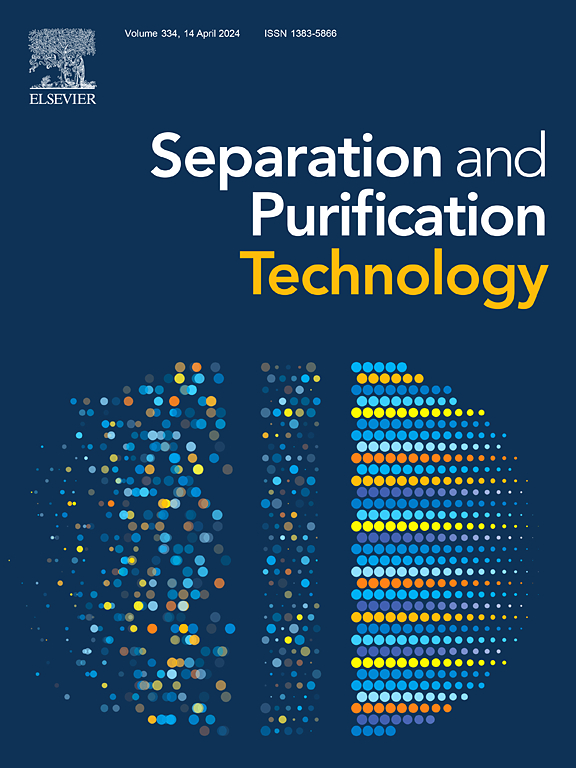Multi-stage recovery of ammonia–potassium liquid fertilizer and phosphate mineral from real human urine
IF 8.1
1区 工程技术
Q1 ENGINEERING, CHEMICAL
引用次数: 0
Abstract
This study explores a novel multi-stage process for recovering valuable nutrients–nitrogen, phosphorus, and potassium–from real hydrolyzed urine as value-added products. The approach utilizes a combination of membrane contactor, zeolite ion exchange, and mineral precipitation techniques. A closed-loop system was established by reusing the acid regeneration solution from ion exchange as the acid-stripping solution in the hollow fiber membrane contactor (HFMC), thereby minimizing chemical usage. Ammonia recovery using the HFMC achieved over 90 % removal across three cycles from hydrolyzed urine. Zeolite columns of chabazite and clinoptilolite demonstrated consistent potassium recovery from HFMC-treated urine, with slightly higher uptake by chabazite compared with clinoptilolite. This suggests zeolite selection can be based on cost and availability. The regeneration of the potassium-saturated zeolite columns using sulfuric acid exhibited rapid and substantial amounts of potassium desorption. Potassium regeneration remained stable over two cycles, with potassium concentrations reaching up to 14 g/L. The release of other ions, such as sodium, was minor compared with potassium, highlighting the minimal impact of sodium interference. The combined ammonia–potassium liquid fertilizer exhibited a favorable N:K mass ratio (3.6 % N and 0.7 % K), with negligible amounts of other ions, making it suitable for facilitating plant growth. Iron phosphate precipitation, a promising alternative resource for fertilizer or lithium iron phosphate batteries, was successfully achieved. Iron doses were more effective in precipitating phosphate at neutral pH than basic pH, reaching over 90 % phosphate removal. This study provides a promising approach for recovering valuable resources from human urine, promoting a more sustainable approach to wastewater management and nutrient recycling.从真实人尿中多级回收氨钾液体肥料和磷酸盐矿物质
本研究探索了一种新颖的多级工艺,可从真正的水解尿液中回收有价值的营养物质--氮、磷和钾,作为增值产品。该方法结合使用了膜接触器、沸石离子交换和矿物沉淀技术。通过重复使用离子交换产生的酸再生溶液作为中空纤维膜接触器(HFMC)中的酸脱除溶液,建立了一个闭环系统,从而最大限度地减少了化学品的使用。使用中空纤维膜接触器进行的氨回收在三个循环中对水解尿液的去除率超过 90%。从 HFMC 处理过的尿液中回收钾的沸石柱(沸石和沸石)表现一致,沸石的吸收率略高于沸石。这表明可以根据成本和可用性来选择沸石。使用硫酸对钾饱和的沸石柱进行再生时,钾被快速大量解吸。钾再生在两个周期内保持稳定,钾浓度最高可达 14 克/升。与钾相比,钠等其他离子的释放量很小,这说明钠的干扰影响很小。氨钾复合液体肥料表现出良好的氮:钾质量比(3.6% 的氮和 0.7% 的钾),其他离子的含量微乎其微,适合促进植物生长。成功实现了磷酸铁沉淀,这是一种很有前途的肥料或磷酸铁锂电池替代资源。铁剂量在中性 pH 比碱性 pH 条件下沉淀磷酸盐的效果更好,磷酸盐去除率超过 90%。这项研究为从人类尿液中回收有价值的资源提供了一种前景广阔的方法,促进了一种更可持续的废水管理和养分回收方法。
本文章由计算机程序翻译,如有差异,请以英文原文为准。
求助全文
约1分钟内获得全文
求助全文
来源期刊

Separation and Purification Technology
工程技术-工程:化工
CiteScore
14.00
自引率
12.80%
发文量
2347
审稿时长
43 days
期刊介绍:
Separation and Purification Technology is a premier journal committed to sharing innovative methods for separation and purification in chemical and environmental engineering, encompassing both homogeneous solutions and heterogeneous mixtures. Our scope includes the separation and/or purification of liquids, vapors, and gases, as well as carbon capture and separation techniques. However, it's important to note that methods solely intended for analytical purposes are not within the scope of the journal. Additionally, disciplines such as soil science, polymer science, and metallurgy fall outside the purview of Separation and Purification Technology. Join us in advancing the field of separation and purification methods for sustainable solutions in chemical and environmental engineering.
 求助内容:
求助内容: 应助结果提醒方式:
应助结果提醒方式:


